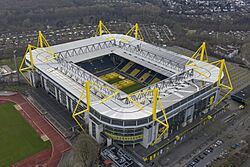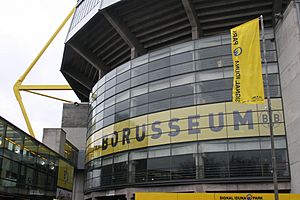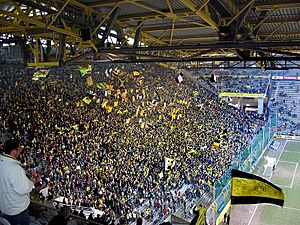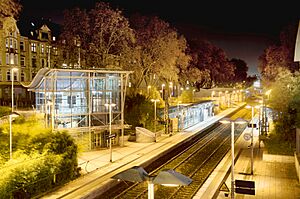Westfalenstadion facts for kids
|
Westfalenstadion
BVB Stadion Dortmund (UEFA competitions) |
|
 
|
|
| Full name | Signal Iduna Park |
|---|---|
| Former names | Westfalenstadion FIFA World Cup Stadium Dortmund (2006 FIFA World Cup) |
| Location | Strobelallee 50 44139 Dortmund, North Rhine-Westphalia, Germany |
| Owner | Borussia Dortmund GmbH & Co. KGa |
| Operator | Borussia Dortmund GmbH & Co. KGa |
| Executive suites | 11 |
| Capacity | 81,365 (domestic matches), 66,099 (international matches) Capacity history
53,872 (1974–1992)
42,800 (1992–1996) 54,000 (1996–1999) 68,600 (1999–2003) 83,000 (2003–2005) 81,264 (2005–2006) 80,708 (2006–2008) 80,552 (2008–2010) 80,720 (2010–2011) 80,645 (2012–2013) 80,667 (2014) |
| Record attendance | 83,000 |
| Field size | 105 by 68 m (344 by 223 ft) |
| Construction | |
| Built | 1971–1974 |
| Opened | 2 April 1974 |
| Renovated | 1992, 1995–99, 2002–03, 2006 |
| Construction cost | DM32.7 million (1974) estimated €200 million (2006) |
| Architect | Planungsgruppe Drahtler |
| Tenants | |
| Borussia Dortmund (1974–present) Germany national football team (selected matches) Borussia Dortmund II (selected matches) |
|
Signal Iduna Park is a famous football stadium in Dortmund, Germany. It is the home ground for the football club Borussia Dortmund. Many people still call it by its original name, Westfalenstadion. For big international games, like those organized by UEFA, it's known as BVB Stadion Dortmund. The name "Westfalenstadion" comes from the old region of Westphalia.
This stadium is the biggest in Germany. It can hold 81,365 fans for local league matches. For international games, where everyone must be seated, it holds 66,099 people. It's one of the largest stadiums in Europe. In the 2011–12 season, it set a European record for the most fans attending games on average.
One of the most famous parts of the stadium is the Südtribüne, or South Bank. This area can hold 24,454 standing fans. It's the largest standing terrace in European football. Fans call it Die Gelbe Wand, which means "The Yellow Wall," because of the sea of yellow jerseys. This wall creates an amazing and loud atmosphere during games. Inside the stadium, you can also find the Borusseum, which is a museum about Borussia Dortmund.
The stadium has hosted many important football events. These include matches for the 1974 FIFA World Cup and the 2006 FIFA World Cup. It also hosted the 2001 UEFA Cup final. Many national team games and European club competitions have taken place here.
Contents
Stadium History
Plans for a new stadium started in the 1960s. Borussia Dortmund's old stadium, the Stadion Rote Erde, was too small. The team had won a European trophy in 1966, and more fans wanted to watch them play. However, the city of Dortmund didn't have enough money to build a new stadium.
In 1971, Dortmund got a chance to host games for the 1974 FIFA World Cup. This meant they received money that was originally meant for another city. Because of a tight budget, they had to change their plans. Instead of a very expensive 60,000-seat stadium, they built a simpler 54,000-seat football arena. This new stadium was made using pre-made concrete parts to save money.
The stadium officially opened on April 2, 1974. Borussia Dortmund has played there ever since. In 1976, the team moved up to Germany's top league, the Bundesliga. They played their first game in this new home stadium. On May 16, 2001, the Westfalenstadion hosted the 2001 UEFA Cup final. This was a big match between Liverpool and Alavés.
1974 FIFA World Cup Matches
The Westfalenstadion hosted four matches during the 1974 FIFA World Cup. The stadium could hold 54,000 fans at that time.
One special game was between Scotland and Zaire on June 14. This was the first time a team from Sub-Saharan Africa played in a FIFA World Cup.
| Date | Team #1 | Res. | Team #2 | Round | Spectators | Ref |
|---|---|---|---|---|---|---|
| 14 June 1974 | 2–0 | Group 2 | 25,000 | |||
| 19 June 1974 | 0–0 | Group 3 | 53,700 | |||
| 23 June 1974 | 4–1 | Group 3 | 52,100 | |||
| 3 July 1974 | 2–0 | Group A | 52,500 |
2006 FIFA World Cup Matches
The stadium was also a host for the 2006 FIFA World Cup. During this tournament, it was called FIFA World Cup Stadium Dortmund because of sponsorship rules.
Six games were played here. Germany lost a game at this stadium for the first time ever, a 2–0 defeat to Italy. Trinidad and Tobago also played their very first World Cup match here against Sweden.
| Date | Time (CET) | Team #1 | Result | Team #2 | Round | Spectators | Ref |
|---|---|---|---|---|---|---|---|
| 10 June 2006 | 18:00 | 0–0 | Group B | 62,959 | |||
| 14 June 2006 | 21:00 | 1–0 | Group A | 65,000 | |||
| 19 June 2006 | 15:00 | 0–2 | Group G | 65,000 | |||
| 22 June 2006 | 21:00 | 1–4 | Group F | 65,000 | |||
| 27 June 2006 | 17:00 | 3–0 | Round of 16 | 65,000 | |||
| 4 July 2006 | 21:00 | 0–2 | Semi-finals | 65,000 |
UEFA Euro 2024 Matches
The stadium hosted six matches for the UEFA Euro 2024 tournament. These included a Round of 16 game and a Semi-finals match.
| Date | Time (CET) | Team #1 | Result | Team #2 | Round | Spectators | Ref |
|---|---|---|---|---|---|---|---|
| 15 June 2024 | 21:00 | 2–1 | Group B | 60,512 | |||
| 18 June 2024 | 18:00 | 3–1 | Group F | 59,127 | |||
| 22 June 2024 | 18:00 | 0–3 | 61,047 | ||||
| 25 June 2024 | 18:00 | 1–1 | Group D | 59,728 | |||
| 29 June 2024 | 21:00 | 2–0 | Round of 16 | 61,612 | |||
| 10 July 2024 | 21:00 | 1–2 | Semi-finals | 60,926 |
Stadium Layout
The Westfalenstadion is built next to the old Stadion Rote Erde. It has four main stands, each with a roof. These stands face the playing field from the east, south, west, and north. The east and west stands run along the sides of the field. The north and south stands are behind the goals.
When it was first built, the corners between the stands were open. The large roof covered most of the seating areas. The east and west stands had 17,000 seats. The north and south stands had 37,000 standing places.
The "Yellow Wall" is on the southern side of the stadium. It is the largest standing grandstand in Europe, holding 25,000 fans. This "Yellow Wall" makes the Westfalenstadion one of the most exciting places to watch football in Europe. Even famous players like Bastian Schweinsteiger have said that the Yellow Wall scares them the most.
Stadium Expansions
The stadium has been expanded several times over the years. The first big expansion happened between 1971 and 1974 for the FIFA World Cup. A large roof, weighing 3000 tons, was added around the stadium.
In 1992, the stadium's capacity was reduced to 42,800. This was because some standing areas were changed into seats to follow new rules. After Borussia Dortmund won the Bundesliga in 1995, the stadium was expanded again. New sections were added to the east and west stands, bringing the capacity back to 54,000. Most of these were now covered seats.
After Dortmund won the 1996–97 UEFA Champions League in 1997, the stadium needed to be even bigger. The north and south stands were expanded, increasing the total capacity to 68,800. The southern standing area, "Die Südtribüne," became the largest of its kind in Europe.
When Germany won the bid to host the 2006 World Cup, the Westfalenstadion was chosen as a key venue. To meet FIFA's requirements for hosting semi-final matches, the stadium was expanded a third time. Four new stands were built in the corners, increasing the seating capacity for international games to 67,000. These new corners also added special seating and food areas for VIP guests. To make sure everyone had a clear view, the old roof supports were removed. They were replaced with yellow pylons on the outside, matching the team's colors.
During these renovations, something surprising was found. Construction workers discovered an unexploded 1,000-pound (450 kg) bomb from World War II. It was buried about one meter under the middle of the pitch! Bomb experts had to safely remove it, and people living nearby were temporarily moved for safety.

The stadium is known for being one of the largest and most comfortable in Europe. It has a glass front, heating under the grass (so games can be played in winter), and the famous "Yellow Wall." It is Germany's largest stadium, with a capacity of 81,360. The last major renovation was for the 2006 FIFA World Cup. There are four large video screens inside the stadium. A smaller fifth screen is on the outside of the north stands.
Since December 1, 2005, the stadium has been called Signal Iduna Park. This is because of a sponsorship deal with an insurance company. This agreement was extended in February 2022 and will last until 2031.
The stadium now holds up to 81,365 fans for league matches. For international games, where all fans must be seated, it holds 65,829 spectators. The famous Southern grandstand is fitted with seats for these international matches. Ticket prices here are among the lowest compared to other big European football leagues. This makes it a popular place for many fans to visit.
Since the 2022–23 UEFA Champions League season, fans have been allowed to stand during Champions League games. This means the capacity for these matches is now the same as for league matches, at 81,365.
Stadium Ownership
The Westfalenstadion originally belonged to the city of Dortmund. Later, it was sold to the club, Borussia Dortmund. In 2002, the club faced money problems. So, the stadium was sold to a real estate group.
Borussia Dortmund planned to buy the stadium back over time. However, in 2005, the club had trouble making payments. The real estate group helped the club by changing the payment plan. This helped the club avoid going bankrupt and secured the stadium's future. In 2006, Borussia Dortmund bought the stadium back with a loan. They paid off this loan in 2008.
To help reduce debt, the club sold the naming rights of the stadium to an insurance company called Signal Iduna. That's why, since 2005, the stadium has been known as "Signal Iduna Park." During the 2006 FIFA World Cup, it was called "FIFA World Cup Stadium, Dortmund" because Signal Iduna was not a sponsor of FIFA. The naming rights deal was extended in 2022 and will continue until 2031.
Getting to the Stadium
You can reach Signal Iduna Park easily by public transport. The Dortmund Stadtbahn (light rail) has several lines that go to the stadium. Lines U42, U45, and U46 all have stops nearby. The U45 and U46 even have a special station called Stadion that only opens on game days.
Deutsche Bahn trains also serve the Dortmund Signal-Iduna-Park station. You can take regional trains from Dortmund Central Station and other nearby cities. Some fans also get off at the Möllerbrücke station and walk to the stadium. This walk takes them through the Kreuzviertel area.
If you're coming from Dortmund Airport, you can take a shuttle bus to the Holzwickede/Dortmund Airport train station. From there, take the RB59 train towards Dortmund Central Station and get off at Signal Iduna Park.
By car, you can reach the stadium using the B 1 Ruhrschnellweg and B 54 roads. There's also parking available at the Technical University of Dortmund. Shuttle buses take fans from there to the stadium.
Around the Stadium
The Kreuzviertel neighborhood is near the stadium. It's known for its many bars, pubs, and cafes. This area has a lively atmosphere, especially on match days. Many fans like to stop here for a drink or a snack before heading to the game. You'll find traders selling beer, sausages (Bratwurst), and team jerseys on the streets.
On the north side of the stadium, there are hotels and apartments. There's also a football-themed restaurant called "Mit Schmackes." This restaurant was started by former Borussia Dortmund player Kevin Grosskreutz.
Across the highway, you can see the Trade fair area with its Westfalenhallen and the TV Tower called Florianturm. From the Florianturm, you can get a great view of the stadium.
See also
 In Spanish: Signal Iduna Park para niños
In Spanish: Signal Iduna Park para niños
- Lists of stadiums






